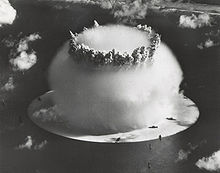Wilson cloud
A Wilson cloud is a cloud of water mist that is created as a result of the pressure changes in a powerful explosion. The Wilson cloud was named because of the similar effect in the Wilson cloud chamber developed by Charles Thomson Rees Wilson .

Mechanism of origin
When a nuclear weapon or a large amount of conventional explosives explode, a powerful shock wave forms in the air. The compressing part of the pressure wave is followed by a relaxing one, at which the pressure and temperature of the air (via an adiabatic change in state ) fall below the condensation point of water. The water vapor present in the air condenses and forms a mist. If the pressure normalizes again, the cloud also dissolves again.
Examples
In the case of nuclear weapon explosions , the effect occurs with the appropriate humidity , which is especially present in explosions in or above water. Examples are the US nuclear weapons tests in Bikini Atoll . The Wilson Cloud, which is dome-shaped at the beginning, later disintegrates into a ring-shaped cloud before it finally dissolves.
An example of a non-nuclear explosion that triggered the effect is the catastrophic explosion in the port of Beirut 2020th
See also
Individual evidence
- ^ A b c Samuel Glasstone, Philip J. Dolan: The effects of nuclear weapons . Ed .: US Department of Defense, US Department of Energy. 3. Edition. Washington 1977, p. 43 ff . (English, hathitrust.org [accessed August 7, 2020]).
- ↑ Medical ABC - fireball - underwater detonations . Archived from the original on June 17, 2014. Retrieved on August 6, 2020.
- ↑ Rare phenomenon: explosion in Beirut leads to cloud formation! August 5, 2020, accessed on August 5, 2020 (German).